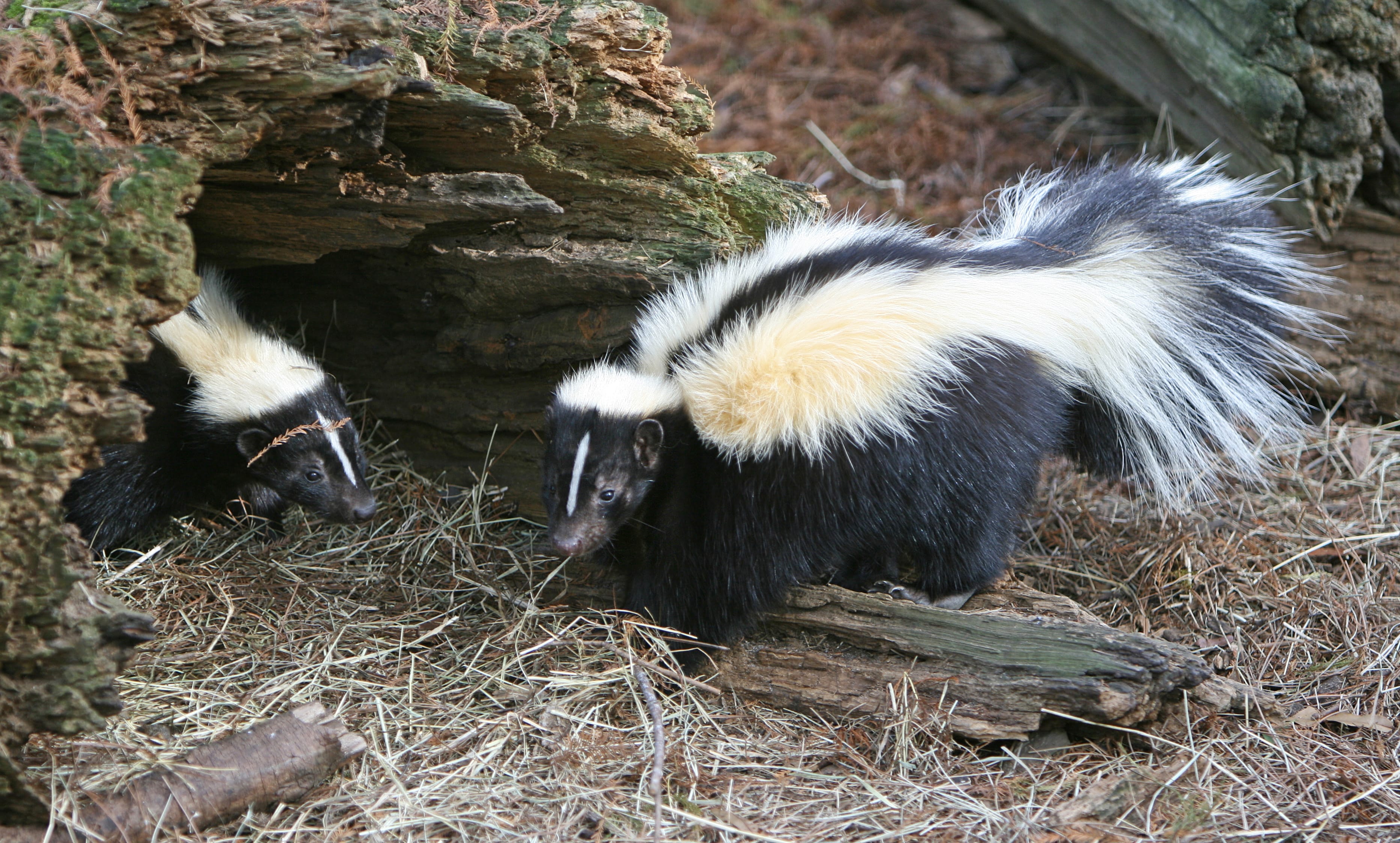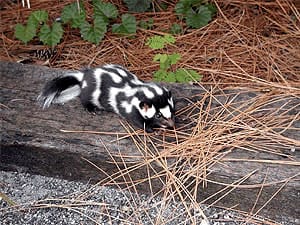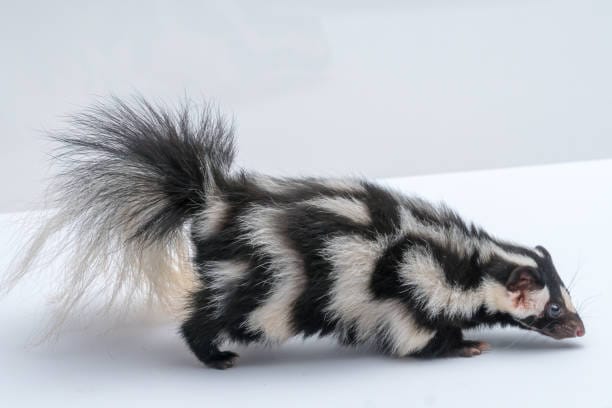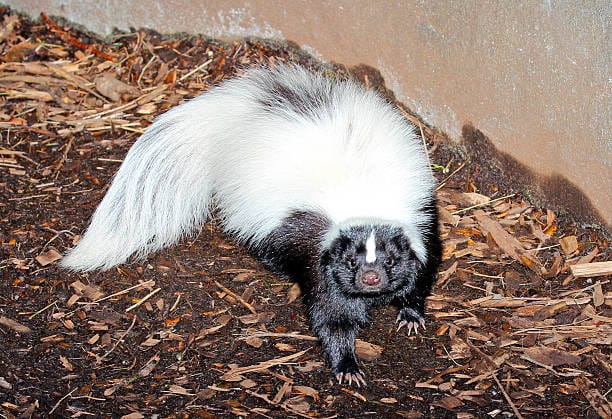Indiana is home to a fascinating array of skunks, nocturnal mammals that are both intriguing and ecologically valuable. From the familiar striped skunk to elusive spotted species, these mammals play a vital role in controlling insect populations and maintaining balance in local ecosystems. Observing skunks in Indiana offers wildlife enthusiasts a glimpse into behaviors shaped by nocturnal life, clever foraging, and subtle social interactions. Even in suburban backyards, one might encounter these shy animals, though they are often most active at night or during twilight hours. Understanding their characteristics, habitats, and habits not only deepens appreciation but also helps in coexisting safely with these remarkable creatures.
1. Striped Skunk (Mephitis mephitis)

Physical Characteristics & Identification Tips
Fun fact: the Striped Skunk is perhaps the most iconic of all skunks in Indiana. Adults measure 20–30 inches from head to tail, with a broad white stripe that usually runs from the top of the head down the back, sometimes splitting into a “V” shape along the shoulders. The bushy tail is tipped in white, and their short, powerful limbs are equipped with sharp claws perfect for digging. Striped Skunks are instantly recognizable due to their bold black-and-white coloration, which acts as a warning to predators.
Behavior
These skunks are primarily nocturnal, emerging at dusk to forage for insects, small rodents, and plant material. They are solitary animals, except during mating season or when mothers care for kits. Striped Skunks are famous for their defensive spray, a chemical deterrent that can reach distances up to 10 feet. Before deploying their scent, they often provide warning signs such as stomping, hissing, and raising their tail, allowing many encounters to end without incident.
Habitat and Range
Striped Skunks are highly adaptable, found throughout Indiana in forests, grasslands, agricultural areas, and even suburban neighborhoods. They prefer areas with dense vegetation or brush for cover and select den sites under logs, abandoned burrows, or human structures for protection. Their ability to thrive near human development is a testament to their ecological flexibility.
Diet
Omnivorous and opportunistic, Striped Skunks feed on insects, larvae, small mammals, fruits, and seeds. In summer, insects dominate their diet, whereas plant matter and fruits provide sustenance in the colder months. They have a remarkable ability to remember locations where food sources were abundant, returning to those spots seasonally.
Reproduction and Life Cycle
Breeding occurs in late winter to early spring. Females produce 4–7 kits in a den lined with soft vegetation. The kits are blind and helpless at birth, emerging after six to eight weeks. Adults typically live 2–3 years in the wild, though some individuals survive up to five years under favorable conditions.
Fun Facts / Unique Traits
Striped Skunks are excellent natural pest controllers, consuming thousands of insects annually. Their spray contains sulfur compounds that are highly effective at deterring predators. Observing their warning behaviors—tail flicks, hisses, and stamping—is both fascinating and an excellent example of animal communication.
Human Interaction
Encounters with humans are common, especially near residential areas. Most Striped Skunks are shy and will retreat if given space. Installing fencing around gardens, securing trash, and avoiding sudden movements can reduce conflicts. Wildlife enthusiasts can also observe these animals safely using motion-sensor cameras or nighttime hikes.
2. Eastern Spotted Skunk (Spilogale putorius)

Physical Characteristics & Identification Tips
Fun fact: the Eastern Spotted Skunk is much smaller and more delicate than its striped cousin. Adults measure 12–20 inches including the tail, with distinctive broken white stripes and spots across a dark coat. A small white spot is often present on the forehead. Their slender frame allows rapid and nimble movements, ideal for escaping predators and navigating complex terrain.
Behavior
Eastern Spotted Skunks are nocturnal and exceptionally agile. Unlike Striped Skunks, they can climb shrubs or low fences. When threatened, they perform a characteristic “handstand,” raising their front paws and tail over their back, sometimes accompanied by spraying. They are primarily solitary but may share dens in colder months to conserve warmth.
Habitat and Range
These skunks inhabit the eastern and southeastern regions of Indiana, often in grasslands, forest edges, or near abandoned structures. Dens are usually underground burrows, often repurposed from other animals. Due to habitat fragmentation, spotting them can be challenging, but tracks and scat often indicate their presence.
Diet
Eastern Spotted Skunks are omnivores, feeding on insects, small mammals, bird eggs, fruits, and seeds. Their diet shifts seasonally, with insects providing most summer nutrition, and seeds and fruits sustaining them in fall and winter.
Reproduction and Life Cycle
Breeding occurs in late winter, with 3–5 kits born in spring. Kits remain in the den for about six weeks, learning essential foraging and climbing skills. These skunks generally live 2–3 years in the wild, though habitat loss and predation are major limiting factors.
Fun Facts / Unique Traits
Their “handstand” display is a remarkable defensive behavior, unique among skunks. Though small, they can deliver a surprisingly potent spray. Population numbers are declining in some areas, making sightings a special opportunity for wildlife enthusiasts.
Human Interaction
Due to their secretive nature, Eastern Spotted Skunks are rarely seen. When encountered, they should be observed from a distance. Preserving natural burrows and brush habitats helps support local populations.
3. Western Spotted Skunk (Spilogale gracilis)

Physical Characteristics & Identification Tips
Fun fact: the Western Spotted Skunk resembles the Eastern species but has broader, broken stripes and a slightly larger body. Adults measure 14–21 inches with a bushy, white-tipped tail. Their fur patterns provide camouflage in the rocky foothills and wooded areas of western Indiana. Observers may notice subtle differences in skull shape and tail length compared to Eastern Spotted Skunks.
Behavior
Western Spotted Skunks are nocturnal and highly agile, capable of climbing low shrubs. They perform the signature “handstand” when threatened and will spray if necessary. These skunks are solitary but occasionally den communally in winter.
Habitat and Range
They inhabit Indiana’s western regions, preferring open woodlands, foothills, and areas with rock outcrops or dense vegetation. They rarely enter urban environments, favoring more remote and semi-arid habitats.
Diet
Their diet mirrors other spotted skunks: insects, small mammals, eggs, fruits, and seeds. Seasonal shifts in diet help them adapt to the availability of prey in various habitats.
Reproduction and Life Cycle
Breeding occurs in late winter, producing litters of 3–5 kits. Juveniles remain in dens for several weeks before venturing out. Adult lifespan ranges 2–4 years in the wild.
Fun Facts / Unique Traits
Western Spotted Skunks are skilled at hunting insects and small rodents, providing natural pest control. Their climbing ability and striking patterns make them a fascinating species to observe.
Human Interaction
These skunks are rarely nuisances due to their preference for remote areas. Observing them offers insight into nocturnal mammal behavior, highlighting Indiana’s diverse wildlife.
4. Hog-Nosed Skunk (Conepatus leuconotus)

Physical Characteristics & Identification Tips
Fun fact: the Hog-Nosed Skunk stands out due to its distinctive upturned nose, which helps it forage for insects and larvae underground. Adults measure 22–30 inches including the bushy tail. Their fur is mainly black with a broad white stripe down the back and tail. Unlike striped or spotted skunks, Hog-Nosed Skunks have longer claws and muscular forelimbs adapted for digging, giving them a stocky, almost “bulldozer-like” appearance.
Behavior
Primarily nocturnal and solitary, Hog-Nosed Skunks are cautious and deliberate in their movements. They use their keen sense of smell to locate invertebrates hidden beneath soil or leaf litter. When threatened, they raise their tail and arch their back as a warning. While capable of spraying, this species often relies on stealth and retreat rather than chemical defense.
Habitat and Range
In Indiana, Hog-Nosed Skunks are rare but occasionally observed in open fields, grasslands, and farmlands with soft, sandy soils suitable for digging. They utilize abandoned dens, hollow logs, or dense vegetation for shelter, often selecting locations that offer protection from predators and seasonal weather extremes.
Diet
This skunk is largely insectivorous but opportunistic, feeding on beetles, grasshoppers, larvae, small mammals, fruits, and seeds. Seasonal shifts occur: insects dominate summer diets, while plant matter or eggs supplement their winter meals. Their digging ability enables them to access prey that other skunk species cannot reach.
Reproduction and Life Cycle
Breeding occurs in late winter, producing 2–5 kits per litter in spring. Kits are born blind and helpless, remaining in dens for the first six to eight weeks. Adult lifespan averages 3–4 years in the wild, though predation and human activity can limit survival. Dens are critical for raising young and sheltering during harsh weather.
Fun Facts / Unique Traits
Hog-Nosed Skunks are excellent diggers, often flipping rocks and soil while foraging. Their upturned nose is a specialized evolutionary adaptation for subterranean hunting. Unlike other skunks, they sometimes rely more on stealth than spraying, making them particularly elusive.
Human Interaction
Due to their low population density and nocturnal habits, Hog-Nosed Skunks are rarely seen by humans. When encounters occur, it is usually near farmland or open fields. Educating locals about their role in controlling insect populations can foster coexistence and reduce unnecessary fear.
5. Regional Variant / Rare Skunk in Indiana

Physical Characteristics & Identification Tips
Fun fact: Indiana’s lesser-known skunk variant exhibits subtle differences in fur patterns, size, and behavior compared to common skunks. Adults measure 18–28 inches, usually with black fur accented by thinner or broken white stripes. Observers may notice variations in tail length or body mass, reflecting adaptations to local habitats.
Behavior
This variant is nocturnal and solitary. Foraging habits are similar to other skunks, consuming insects, small rodents, and plant material. Defensive behavior includes tail-raising, foot-stamping, and spraying when necessary. These skunks are cautious and often avoid humans, making sightings rare.
Habitat and Range
Found in scattered regions of Indiana, particularly in woodlands, farmlands, and brushy hillsides. They prefer dens in natural shelters or abandoned burrows and may share dens in winter for warmth. Habitat fragmentation contributes to their limited distribution.
Diet
Omnivorous and opportunistic, feeding on insects, small mammals, eggs, fruits, and seeds. Seasonal variation occurs with insects dominating in summer and plant material in colder months. Digging and burrowing allow access to food sources unavailable to other skunks.
Reproduction and Life Cycle
Breeding takes place in late winter. Litters typically include 2–4 kits, which remain in dens for several weeks before venturing out. Lifespan averages 3–4 years, influenced by predation, disease, and human activity.
Fun Facts / Unique Traits
These rare skunks demonstrate adaptability to Indiana’s diverse environments. Their subtle coat patterns and elusive nature make them fascinating to wildlife enthusiasts. Observing indirect signs like tracks or diggings often reveals their presence more than direct sightings.
Human Interaction
Encounters are uncommon. Maintaining brushy edges, protecting natural burrows, and avoiding unnecessary disturbance can help preserve these little-known skunks. Educating the public about their ecological role promotes coexistence and reduces conflict.
Indiana’s skunk diversity—from the widespread Striped Skunk to elusive spotted species and rare Hog-Nosed variants—highlights the richness of nocturnal wildlife in the state. Each species contributes to ecological balance, from controlling insect populations to aerating soil, and offers unique behaviors that enrich our understanding of local ecosystems. Observing these mammals requires patience, respect, and curiosity, revealing the subtle intricacies of nocturnal life in Indiana.
Frequently Asked Questions (FAQs) about Skunks in Indiana
1. Are there skunks in Indiana?
Yes, Indiana is home to several skunk species, including Striped, Eastern Spotted, Western Spotted, Hog-Nosed, and some regional variants.
2. How many types of skunks live in Indiana?
There are at least five recognized types of skunks in Indiana.
3. What is the most common skunk in Indiana?
The Striped Skunk (Mephitis mephitis) is the most widespread and frequently encountered species in the state.
4. Are spotted skunks found in Indiana?
Yes, both Eastern Spotted Skunks (Spilogale putorius) and Western Spotted Skunks (Spilogale gracilis) inhabit Indiana, though sightings are rare.
5. What is a Hog-Nosed Skunk?
The Hog-Nosed Skunk (Conepatus leuconotus) is a rare species in Indiana with an upturned nose and broad white stripe down its back.
6. Can skunks spray humans?
Yes, all skunks can spray a defensive odor when threatened, but they usually provide warning signs before doing so.
7. Are skunks nocturnal in Indiana?
Yes, most skunks are nocturnal, foraging primarily at night or during twilight hours.
8. What do skunks eat in Indiana?
Skunks are omnivorous, eating insects, small mammals, eggs, fruits, seeds, and occasionally carrion.
9. Do skunks hibernate in Indiana?
No, skunks do not truly hibernate, but they may remain less active during the coldest winter months.
10. When do skunks breed in Indiana?
Skunks typically breed in late winter, with kits born in early spring.
11. How many babies do skunks have?
Litter sizes vary: Striped Skunks usually have 4–7 kits, while spotted and Hog-Nosed skunks may have 2–5 per litter.
12. Where do skunks live in Indiana?
Skunks inhabit forests, grasslands, agricultural lands, and suburban areas, often using burrows, hollow logs, or dense vegetation for shelter.
13. Are skunks aggressive?
Skunks are generally shy and non-aggressive, resorting to spraying only when threatened.
14. Are skunks dangerous to humans?
Skunks are not inherently dangerous, though they can carry rabies in rare cases.
15. Can skunks climb trees?
Spotted skunks are excellent climbers, while Striped and Hog-Nosed Skunks are mostly terrestrial.
16. How long do skunks live in the wild?
Most skunks live 2–4 years, though some Striped Skunks may survive up to 5 years.
17. Are skunks solitary?
Yes, skunks are generally solitary except during mating season or winter den sharing.
18. Can skunks swim?
Yes, skunks are capable swimmers, but they usually remain on land.
19. Do skunks have predators in Indiana?
Yes, skunks are preyed upon by owls, hawks, foxes, coyotes, bobcats, and domestic pets.
20. How do skunks mark their territory?
Skunks use their scent glands to mark territory, supplemented by visual and auditory warning signals.
21. How do spotted skunks differ from striped skunks?
Spotted skunks are smaller, more agile, and have broken stripes or spots rather than a continuous stripe.
22. Are skunks beneficial to Indiana ecosystems?
Yes, they help control insect and rodent populations and contribute to soil aeration through digging.
23. Can I feed skunks in Indiana?
Feeding wild skunks is discouraged as it can create dependency and increase human-wildlife conflicts.
24. Are Hog-Nosed Skunks endangered in Indiana?
They are rare and of conservation concern, but not officially listed as endangered in the state.
25. How can I tell Eastern and Western Spotted Skunks apart?
Eastern Spotted Skunks have narrower stripes and smaller size; Western Spotted Skunks are slightly larger with broader patterns and inhabit western regions.
26. Do skunks make noise?
Yes, skunks hiss, growl, and stomp their feet as warnings before spraying.
27. Can skunks dig burrows?
Yes, Striped and Hog-Nosed Skunks are excellent diggers, creating shelters and foraging for insects.
28. Are skunks active during the day?
They are mainly nocturnal, though some may be seen during the day, especially in winter or areas with abundant food.
29. How do skunks interact with humans?
Skunks generally avoid humans, and most interactions occur when humans disturb dens or leave food accessible.
30. Can skunks be kept as pets in Indiana?
It is illegal to keep wild skunks as pets without permits and generally discouraged due to health and behavioral issues.
31. How do skunks defend themselves?
They primarily use chemical defense (spraying), accompanied by visual warnings like tail raising and foot stamping.
32. What are signs of skunk activity?
Signs include tracks, diggings in soil, burrows, scat, and occasional odor near dens or feeding areas.
33. Are skunks nocturnal predators?
Yes, they hunt insects, rodents, and eggs mainly at night, relying on stealth and keen senses.
34. How do skunks survive winter in Indiana?
They remain less active, often using dens or burrows for warmth and sharing shelters with other skunks if necessary.
35. Do skunks have seasonal diets?
Yes, insects and small mammals dominate in summer, while fruits, seeds, and plant matter are more important in winter.
Conclusion
Indiana hosts a remarkable variety of skunks, from the familiar Striped Skunk to the elusive Eastern and Western Spotted Skunks, as well as the rare Hog-Nosed and regional variants. Each species plays a vital role in maintaining ecological balance, whether through controlling insects, small mammals, or aiding in soil aeration. Observing these nocturnal mammals offers insights into their unique behaviors, adaptive strategies, and subtle communication methods. By appreciating and respecting skunks’ habitats—whether forests, grasslands, or suburban edges—we not only enhance our understanding of Indiana wildlife but also contribute to coexistence with these intriguing creatures. Skunks may be shy, but their presence quietly enriches the biodiversity of the state.
